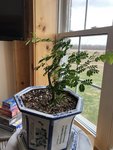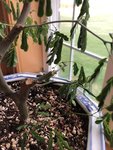Inverse taper = reverse taper - either name is acceptable.
This is a design problem only, no effect on health of a tree. Initially it is not an every day use concept. When those new to bonsai get to the point where they understand the term, often they "fixate" on it, and see inverse taper everywhere. Frequently they view it as a "fatal flaw" that any tree showing any signs of inverse taper is not worthy of being call bonsai and must be immediately relegated to the compost pile. This is completely wrong.
Yes, inverse taper is a design issue. Yes, at a top level exhibition, like the USA National Show in Rochester, a tree of one of the commonly used varieties of trees with strong inverse taper will be rejected from exhibition. But many of the unusual varieties of trees, cork bark pines, natural pachycauls, inverse taper will be overlooked by the judges if it is a normal pattern for the tree in nature or the nature of the cultivar, as in cork bark pines.
In any tree where your description includes "allow the trunk to increase in diameter" - inverse taper is a trivial problem. Inverse taper can be remedied by controlling grow. By allowing branches below the zone of inverse taper to grow rapidly, and by limiting the growth of branches above the inverse taper, one can usually eliminate mild and moderate zones of inverse taper in a matter of 2 to 5 years.
Some trees, such as Brazilian rain tree, develop wide flattened zones in their trunks, they also develop fluting. These flattened zones when viewed from one side might appear as reverse taper, and from 90 degrees to one side might appear as normal narrowing of the trunk. This is normal for Brazilian rain tree and is not viewed as a flaw.
@BrazilianMoistWood - Your inverse taper is caused by the large branch that was removed, now that you have only a small branch remaining on that first branch, the main trunk will grow faster, in just a few years the trunk will be enough larger in diameter that the short first branch will no longer be larger in diameter than the trunk. This will "fix itself" the way you have it set up.
Sometimes pruning is the best way to eliminate a branch whose diameter has become larger than the diameter of the trunk. In design, a general principal, or guideline is that branches in general should be less than 50% of the diameter of the trunk it is coming from. Branches that are over 75% the diameter of the trunk, begin to create the image of a shrub, rather than a tree. Now this is not an absolute rule, and there is the gray area whether a "branch" is really a Branch or is it a "sub-trunk". If it is a sub-trunk it is acceptable to be close to the same diameter as the main trunk. But frequently, especially with deciduous trees that back bud easily, once the young tree has achieved the desired trunk diameter, most if not all branches are removed and replaced to new, small diameter branches.
@BrazilianMoistWood at some point in the future, you might just want to remove that fat stub of a branch flush with the trunk and start over with a new back bud low on the trunk to make your first branch.
So in summary, inverse taper is a design issue. If the description of the tree includes "increasing the trunk diameter" then inverse taper is a relatively easy issue to correct. Don't panic, it is not a "fatal flaw", you can, by controlling growth, fix the problem.




